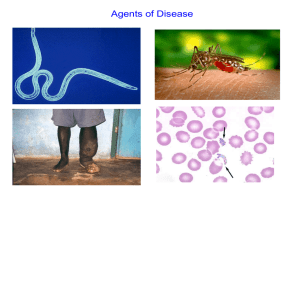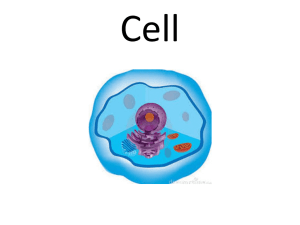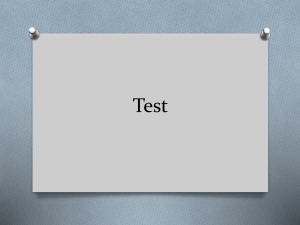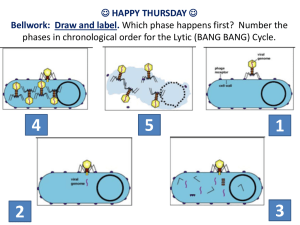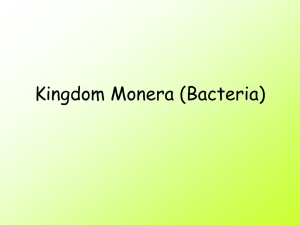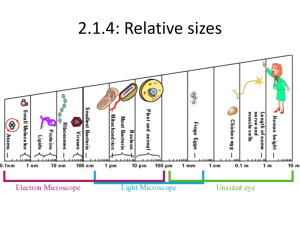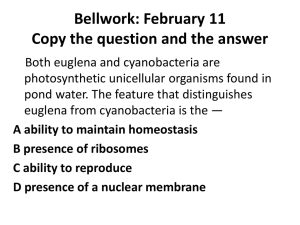Viroids, Prions, Viruses, and Bacteria
advertisement
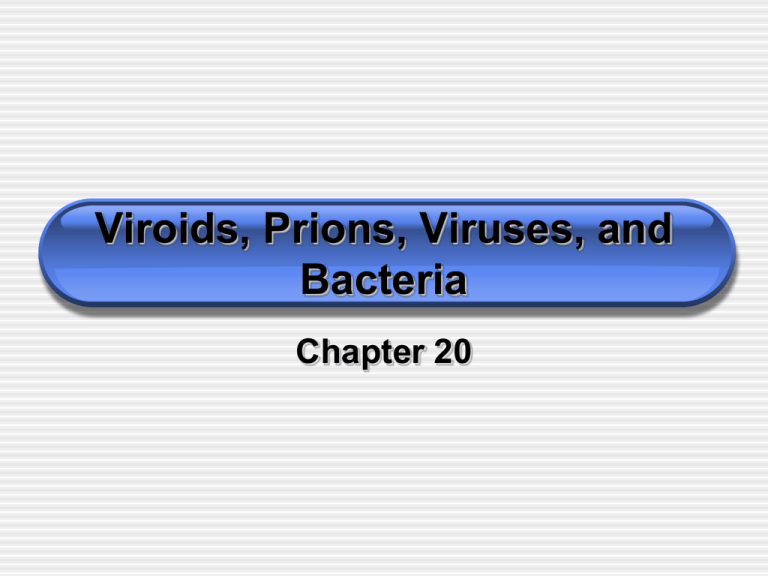
Viroids, Prions, Viruses, and Bacteria Chapter 20 Thinking Question #1 (Partner Activity) A. What is the difference between a bacteria and a virus? B. Are both considered cells? Why or why not? C. Of the following diseases which are caused by viruses or bacteria? -Measles -Chicken pox - Aids, -Botulism -Tuberculosis -Bubonic Plague -Syphilis -Polio -Flu -Mumps - Lyme disease - Strep throat - Common Cold D. Can antibiotics cure all of these diseases, why or why not? Viruses • Viruses are extremely small, non-living, disease-causing • • pathogens that have the ability to infect any organism including bacteria. Viruses are composed of a protein coat (capsid) with either viral DNA or viral RNA. Viruses may only replicate in a living organism. They do not have the ability to reproduce on or in a non-living surface. Flu virus http://science.nationalgeographic.com/science/photos/influenza/flu-virus.htm l Thinking Questions #2 • Thinking Question #2: What is a pathogen? Viruses • Viruses are so small, that they were not discovered until the end of the 19th century when they were trying to find the pathogen that caused tobacco mosaic disease (TMV). • Once discovered, it was called a virus, which is Latin for “poison.” • In 1935, Wendell Stanley finally purified and crystallized the TMV virus. What Are Viruses? • If you recall, Rosalind Franklin, the same one whose • photo 51 of crystallized DNA was “taken” by Watson & Crick, pursued other research interests and began working on trying to figure out the anatomy of a virus. This is what she and others found. 1.)The virus has a protein coat or capsid. 2.) A virus may contain either DNA or RNA, but not both. 3.) Some viruses have an additional membrane or envelope. Structure of Influenza Virus Viral Structures Figure 1 An array of viruses. (a) The helical virus of rabies. (b) The segmented helical virus of influenza. (c) A bacteriophage with an icosahedral head and helical tail. (d) An enveloped icosahedral herpes simplex virus. (e) The unenveloped polio virus. (f) The icosahedral human immunodeficien cy virus with spikes on its envelope. Classification of Viruses • Viruses can be classified according to the following characteristics. 1.) Whether or not they contain DNA or RNA 2.) Their shape 3.) What they infect 4.) Their genetic make-up 5.) The type of disease that they may cause The group of viruses that infect bacteria are called bacteriophages. Bacteriophage Thinking Question #2 • Thinking Question #3: How does a virus get into a cell? Virus Movie • Virus Animation How Does A Virus Get Into A Host Cell • Viruses “know” which organisms to infect because • they try to attach to specific receptor sites, which are usually proteins that are found on the cell membranes of an organism. Once the virus has recognized and attached to the specific organism’s cell membrane receptor site, the virus gains entry by one of two ways 1. Endocytosis 2. Virus injects its DNA or RNA into the cell of the organism. • http://www.courses.fas.harvard.edu/~bi otext/animations/viralinfection.html Virus Entry Lytic vs. Lysogenic Cycle • Once inside the cell, one of two things can happen. 1.) The virus can lay dormant (asleep) inside the cell and not cause the organism to get sick. This is called the lysogenic cycle. Diseases that ‘keep showing up’ such as herpes could be considered lysogenic. 2.) The virus hijacks the cell’s normal cellular functions and tricks the cell into making more viruses. This will eventually kill the cell and cause more viruses to be released. This is called the lytic cycle. Diseases that begin and end over a short period of time such as a cold could be considered lytic. Lysogenic Cycle Animation • Lysogenic Cycle Animation • http://www.courses.fas.harvard.edu/~biote xt/animations/lysogeny.html Lytic Cycle http://www.web-books.com/MoBio/Free/Ch1F1.htm Lytic Cycle • Lytic Cycle Animation • http://www.courses.fas.harvard.edu/~biote xt/animations/lyticcycle.html Thinking Question #4 • Thinking Question #4: What do you think causes a virus that is in the lysogenic cycle to become lytic (Example: Someone that has not had a herpes outbreak for years suddenly has one) Thinking Question #3 • Thinking Question #5: How do you get a virus? How are viruses spread? Viral Transmission • You cannot catch a viral disease from simply touching or • sitting on a surface. The only ways that you can catch a viral disease is from direct contact, an injection, inhalation, or spreading infected body fluids into a cut, your mouth, your nose, or your eyes. Many recent studies have shown that by simply washing your hands prior to eating, rubbing your nose, or rubbing your eyes, you can exponentially reduce your chances of getting a viral infection. http://www.foodlink.org.uk/factfile_c.asp?file=2&chapter=2 http://www.bma.org.uk/ap.nsf/Content/viralrespiratorydisorders~spread http://www.cnn.com/2007/HEALTH/10/31/flu.dos.donts/index.html http://www.sciencedaily.com/videos/2005/1212-fighting_cold_and_flu_germs.htm http://www.southcoast.org/24/flu.html http://www.wcu.edu/4995.asp http://www.health.gov.sk.ca/influenza-schools-parents Some of the diseases which are caused by viruses:• • • • • • • • • AIDS The common cold Ebola Hepatitis A and B Influenza or the flu Mumps Polio Rabies Smallpox Lab Activity • Pass It On Virus Prevention • Inactivated Vaccine: made of virus particles that have • • been killed and cannot replicate. The virus capsid proteins are still intact enough to be recognized by immune system and evoke a response Attenuated Vaccine: Vaccine which uses “live” but weakened/altered virus so it is less virulent. Preferred because these vaccines last longer Antiviral Drugs: drugs that interfere with viral nucleic acids and viral reproduction used to treat HIV, herpes, influenza Thinking Question #6 • Are there other types of pathogens besides viruses and bacteria? Prions • Pathogens discovered in the 1980s and have since • • been shown to be involved a variety of diseases, such as Kuru, Mad Cow, and other brain illnesses. Prions are proteins that “have gone bad.” They find their way into the brain and cause the proteins in the brain to change shape. These newly shaped proteins then create plaques or hard parts in the brain. (The brain is not supposed to have these plaques.). http://jackson.ifas.ufl.edu/bse.htm http://www.ens-newswire.com/ens/jul2006/2006-07-10-03.asp http://scienceblogs.com/retrospectacle/2007/02/basic_concepts_prions.php http://www.sciencemag.org/feature/data/prusiner/245.dtl http://www.biologie.uni-duesseldorf.de/Institute/Physikalische_Biologie/Research/Topics/addinformation2 http://www.cnspathology.com/ Healthy Brain tissue - Note few ‘holes.’ Fig 1: Histopathology shows spongiform changes in brain of A sporadic CJD, B new variant CJD, C Kuru and D BSE (pictures A-C Hans Kretzschmar, M殤chen, D Martin Groschup, Insel Riems) • http://highered.mcgrawhill.com/sites/dl/free/0072835125/126997/a nimation44.html • http://www.youtube.com/watch?v=H2Ouxl_ GNjA Viroids • These are newly discovered infectious agents • that are single pieces of RNA that lack a capsid Several have been identified as plant pathogens while only one so far has been identified as a human pathogen (hepatitis delta). http://www.biologie.uni-hamburg.de/bzf/mppg/agviroid.htm Fig. 2: Symptoms of viroid diseases: A: potato spindle tuber on tomato, B: avocado sun blotch, C: chrysanthemum stunt, D chrysanthemum chlorotic mottle http://www.virtualology.com/ virtualmuseumofnaturalhistory/ halloftaxonomy/viruses/viroids.org/ Bacteria • The ancestors of these organisms are • considered to have been some of the first life forms on Earth given the fossil record. Thinking Question #7: Review A. Are bacteria prokaryotic or eukaryotic, why? http://www.ucmp.berkeley.edu/bacteria/cyanofr.html Bacteria differ from eukaryotes in at least 7 ways. • • • • • • • No organelles Cell size: (1u-5u) Unicellular Plasmids (single circular piece of DNA) Binary fission Flagella (single flagellum in bacterial cells) & Pilli (small outer growths enable bacteria to attach to cells or other surfaces Metabolic diversity Bacterial Flagella & Pilli Metabolic Diversity • Bacteria have the ability to metabolize either under the following conditions: Anaerobic (no oxygen) Aerobic (with oxygen) • They may be: 1. Photosynthetic autotrophs 2. Chemoautotrophs 3. Heterotrophs (decomposers) Photosynthetic bacteria • Photosynthetic Bacteria use energy from sunlight to make food • Four types based on the photosynthetic pigments they contain 1. Purple non-sulfur 2. Cyanobacteria 3. Anaerobic purple sulfur 4.Anaerobic green sulfur Chemoautotrophic Bacteria • Chemoautotrophic Bacteria: use inorganic molecules such as ammonia, hydrogen sulfide, and methane to make their own food. • Live in soil produce chemicals such as nitrates and phosphates, which help fertilize plants. Heterotrophic Bacteria Bacteria • Most bacteria are heterotrophs • Bacteria, along with fungi, are • • the main decomposers for most ecosystems. Anaerobic fermentation (bacteria help produce fermented food like cheese, vinegar & sour dough bread . Yogurt Fungi Thinking Question #8 • Thinking Question #5: Where are bacteria found? http://www.nsf.gov/news/special_reports/sfs/index.jsp?id=life&sid=ext Bacteria Bacteria Everywhere • Since they have adapted a variety of different ways to obtain food, they can be found almost anywhere on Earth. • Often warm moist environments • 80-100 F 90% water Thinking Question #9 • Thinking Question #9 : So why do bacteria make us feel so sick? What are they doing inside our bodies? So Why Do Bacteria Make us Feel So Sick • Some bacteria produce toxins. These chemicals are what cause us to have nausea, diarrhea, and/or vomiting when we are infected with bacteria. • Food poisoning So Why Do Bacteria Make us Feel So Sick • Some can not only produce toxins, but they can also secrete enzymes which destroy our normal cell’s functions. • A human’s normal inflammatory response, which includes a fever, a human’s immune system, vaccinations, and prescribed antibiotics may be effective means to control the bacterial infection. Examples of infections caused by bacteria are:• • • • • • • • • Anthrax Bubonic plague Cholera Dental cavities Lyme disease Tuberculosis Typhus Acne Food poisoning Bacteria come in three shapes. • Bacillus or Rodshaped • Coccus or round • Spirillum or spiral http://universe-review.ca/F11-monocell.htm Bacterial Forms • Some bacteria aggregate in specific ways. Strepto- bacteria group together into long filaments. Staphylo- bacteria group together into clusters. Diplo: two Tetrad: four http://www.ncl.ac.uk/dental/oralbiol/oralenv/tutorials/streps.htm http://nbsp.sonoma.edu/resources/presentations/derekpres/05Microbe%20lecture/sld003.htm Bacterial Killers • Thinking Question # 10: So what kills bacterial cells other than antibiotics? Bacterial Killers • Ammonia: disrupts bacterial cell • • • • membrane Alcohol: breaks down proteins Chlorine: destroys chemical bonds in bacteria Iodine: stops proteins from working Penicillin: stops cell wall formation
